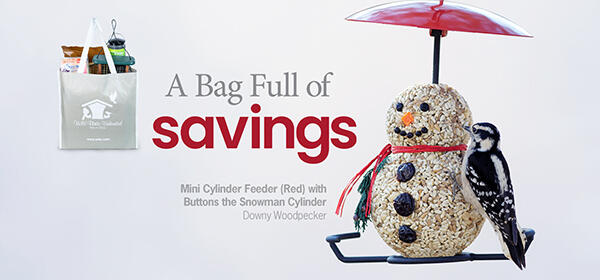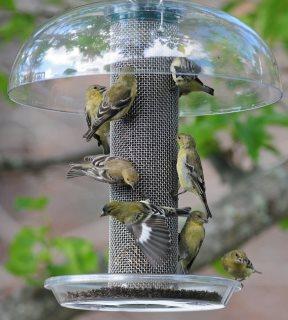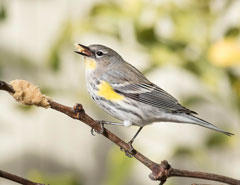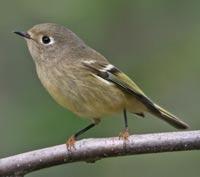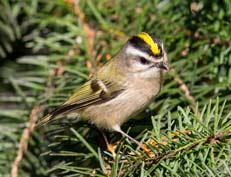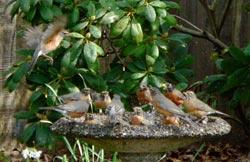November Holiday Hours
Wed., 11/26: Closing early at 2:00 p.m.
Thurs., 11/27: Closed
Fri., 11/28: Closed
Fill-A-Bag Sale on Saturday, 11/29!
Save 25% on Everything You Can Fit in our Shopping Bag!
Store Hours: 10:00 a.m. to 5:00 p.m.
Sale Hours 10:00 a.m. to 3:00 p.m.
This year we will be closed on both Thanksgiving and Black Friday. We hope you are able to join us in the spirit of rest, relaxation, and spending time with loved ones. We wish all of our friends and supporters a safe and happy Thanksgiving.
On Saturday, November 29th, let us say "Thank you" to all of you for supporting us this year. Everything you can fit inside our shopping bag will be 25% off, from Opening at 10 a.m. until 3 p.m. (Some restrictions and exclusions apply.)
Get a jumpstart on your holiday shopping! Whether you are shopping for a loved one, or getting something for yourself, it's a wonderful way to bring nature home for the holidays - all in one bag!
November Nature News
|
Lesser Goldfinches |
By November, most songbirds are settling in on their winter grounds. One general trend among migratory songbirds in coastal California is that we get more insect-eating birds in the summer (most warblers, flycatchers, vireos, orioles, tanagers, etc.) and more seed-eating birds in the winter. This means that as far as activity at your backyard feeding station goes, the winter months are usually the busiest time of year. Goldfinch numbers tend to markedly increase, with some additional migrants amplifying the effect of seasonal food patterns in concentrating these birds at feeders for Nyjer or sunflower chips. Many of our goldfinches take a summer vacation from visiting feeders in favor of natural food sources, but we are now starting to see and hear of more goldfinches coming to feeders. If you’ve had a finch feeder filled with the tiny black seed called Nyjer or thistle, and you haven’t had much activity recently, now is the time to refill with fresh seed so that these newly hungry birds don’t go away in disappointment. Both Nyjer and sunflower feeders may also see increasing numbers of pine siskins, streaky finches with yellow highlights in their wings and tails, as we move farther into fall.
But hungriest of all are probably our winter sparrows, most abundantly the white-crowned and golden-crowned sparrows, but also some white-throated and fox sparrows, all of which will eat seeds like millet and sunflower. While they are habitually accustomed to feeding on the ground, scratching around for fallen seeds, our two common crowned sparrows are more agile than they look when enticing feeders are on offer and will readily hop up and cling to suet feeders for the seconds needed to grab a few mouthfuls. If you’d like to accommodate them specifically, offer a mixed seed like our No-Mess Blend which contains some hulled millet - finches and many other perching songbirds will favor the sunflower chips and diced peanut, leaving the sparrows the millet, either gradually released to the ground below your feeder where they will act as a thorough cleaning crew, or left in the seed-catching tray if your feeder is so equipped, which will act as a comfortable feeding platform for all of their type. To get familiar with the diverse lot making up our winter sparrows, be sure to take a look at last month’s Bird of the Month article.
|
Yellow-rumped Warbler eating Bark Butter |
We do, however, get some insect-eating birds in winter, several of which can be drawn to suet or mealworm feeders. Probably the most common of these at feeders is the lovely Townsend’s warbler, which is not uncommonly seen on suet, mealworm, and even shelled sunflower feeders. Other winter bug-eaters include ruby-crowned kinglets (who will eat suet) and yellow-rumped warblers and hermit thrushes (who will eat mealworms). Some year-round birds like robins, black phoebes, and bushtits are also somewhat more often seen at mealworm or suet feeders in winter when insect prey is scarcer. Out of these, the ruby-crowned kinglet is probably the most often overlooked bird. They are small, drab birds who spend most of their time skittering around, poking around under leaves and in other arboreal nooks and crannies for insects. But drabness is no justification for disdain - we humans, after all, are also lacking in brilliant blues, reds, and yellows in our natural complexions. Though you might wonder at the name - what ruby crown? Let me explain the world of kinglets:
|
Ruby-crowned Kinglet
Photo by Jean-Guy Dallaire
|
Golden-crowned Kinglet
Photo by Mick Thompson
|
Now is also the time to watch out for winter flocks of fruit-eating species like American robins and cedar waxwings, both in native habitats at plants like madrone or toyon, or in suburban areas feeding on pyracantha, Chinese pistache, camphor, and more. Keep an eye on the fruiting trees in your neighborhood – you may well see bluebirds, mockingbirds, and hermit thrushes discretely joining in an unsuspected multi-species banquet right on your street.
|
American Robins at Bird Bath |
Speaking of flocking robins and multi-species banquets: winter is the flocking season for a large portion of the bird world. While many species split up into pairs for the nesting season, when competition for nesting sites and concern over assuring one’s paternity moves up the ladder of priorities, the winter to-do list is simpler: find food, don’t become food. With this set of goals, flocking becomes a more effective strategy as individual birds can take advantage of the collective experience and awareness to find food sources, alert each other of dangerous predators, and perform synchronized feats of predator-baffling flight (most striking perhaps in the big swirling flocks of small sandpipers). In your yard, you’ll see both single-species flocks (waxwings, robins, the winter coveys of quail) and multi-species flocks (white-crowned and golden-crowned sparrows; assorted woodland flocks comprised of kinglets, chickadees, bushtits, warblers, and more).
Beyond the yard, we’re now entering into the thicker part of the waterfowl season. Ducks are still moving into local ponds and marshes, as well as forming massive flocks in the Central Valley. Canvasback, pintail, green-winged teal, bufflehead, ruddy ducks, and more can be seen at local sites like Las Gallinas, Hamilton, or Shollenberger Park, while a trip to the Sacramento area refuges can find huge numbers of snow geese and white-fronted geese, as well as tundra swans and sandhill cranes. Hawk migration is now past its peak, but many raptors will traverse our area throughout the winter, including sharp-shinned hawks, ferruginous hawks, merlins, and peregrine falcons. Sharp-shins may dart after songbirds in your yard (along with their year-round cousin the Cooper’s hawk); many of the others are best seen in open grassland areas and near bodies of water.


